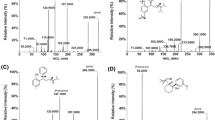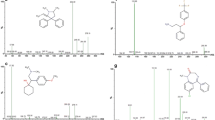Abstract
Methylone is a commonly abused synthetic cathinone derivative marketed as a “legal” alternative to “ecstasy” or cocaine. Previous studies examined the metabolism of methylone in vitro and in vivo; 4-hydroxy-3-methoxymethcathinone (HMMC) was identified as the primary metabolite, with other reported minor metabolites, 3,4-methylenedioxycathinone (MDC) and 3,4-dihydroxymethcathinone (HHMC). However, limited information is known about methylone and its metabolites’ pharmacokinetics. We developed and fully validated a method for the simultaneous quantification of methylone, HMMC, MDC and HHMC by liquid chromatography-tandem mass spectrometry in 100 µl rat and human plasma. β-Glucuronidase was utilized for plasma hydrolysis, followed by perchloric acid protein precipitation and solid-phase extraction utilizing cation exchange columns. Chromatographic separation was performed with a Synergi Polar column in gradient mode, and analytes were determined by two multiple reaction monitoring (MRM) transitions. Linear ranges of 0.5–1,000 µg/l (methylone, HMMC and MDC) and 10–1,000 µg/l (HHMC) were achieved. Bias and imprecision were generally acceptable, although quantification of HHMC exhibited variability (16.2–37 %). Extraction efficiencies and ion suppression were 89.9–104 % (for HHMC, 15.9–16.2 %) and < 11.4 %, respectively. Methylone and metabolites were stable in plasma for 24 h at room temperature, 72 h at 4 °C, and after three freeze–thaw cycles (except for a 60 % HMMC increase). Human and rat plasma were cross-validated, documenting that rat plasma quality control samples were accurately quantified against a human plasma calibration curve (−23.8 to 12 % bias). As proof of method, rat plasma specimens were analyzed pre-injection and after subcutaneous administration of methylone at 6 mg/kg from 15 to 480 min post-dosing. Methylone, HMMC, MDC and HHMC concentrations ranged from 1.1 to 1,310, 11.2 to 194, 1.9 to 152 and 24.7 to 188 µg/l, respectively.


Similar content being viewed by others
References
US DEA (2014) Special report: synthetic cannabinoids and synthetic cathinones reported in NFLIS, 2010–2013. Springfield
American Association of Poison Control Centers AAPC (2014) Bath salts data. https://aapcc.s3.amazonaws.com/files/library/Bath_Salts_Web_Data_through_9.2014.pdf. Accessed 7 Nov 2014
US DEA (2014) National forensic laboratory information system (NFLIS): 2013 midyear report. Springfield
Miller BL, Stogner JM (2014) Not-so-clean fun: a profile of bath salt users among a college sample in the United States. J Psychoactive Drugs 46:147–153
Uralets V, Rana S, Morgan S, Ross W (2014) Testing for designer stimulants: metabolic profiles of 16 synthetic cathinones excreted free in human urine. J Anal Toxicol 38:233–241
Jacob P, Shulgin AT (1996) Novel n-substituted-2-amino-3′,4′-methylene-dioxypropiophenones. US Patent WO1996039133 A1, filed 6 June 1996, and issued 12 December 1996
Bossong MG, Van Dijk JP, Niesink RJ (2005) Methylone and mCPP, two new drugs of abuse? Addict Biol 10:321–323
Pearson JM, Hargraves TL, Hair LS, Massucci CJ, Frazee CC 3rd, Garg U, Pietak BR (2012) Three fatal intoxications due to methylone. J Anal Toxicol 36:444–451
Spiller HA, Ryan ML, Weston RG, Jansen J (2011) Clinical experience with and analytical confirmation of “bath salts” and “legal highs” (synthetic cathinones) in the United States. Clin Toxicol 49:499–505
Tekulve K, Alexander A, Tormoehlen L (2014) Seizures associated with synthetic cathinone exposures in the pediatric population. Pediatr Neurol 51:67–70
Vardakou I, Pistos C, Spiliopoulou C (2011) Drugs for youth via Internet and the example of mephedrone. Toxicol Lett 201:191–195
Winstock AR, Mitcheson LR, Deluca P, Davey Z, Corazza O, Schifano F (2011) Mephedrone, new kid for the chop? Addiction 106:154–161
Cawrse BM, Levine B, Jufer RA, Fowler DR, Vorce SP, Dickson AJ, Holler JM (2012) Distribution of methylone in four postmortem cases. J Anal Toxicol 36:434–439
Carbone PN, Carbone DL, Carstairs SD, Luzi SA (2013) Sudden cardiac death associated with methylone use. Am J Forensic Med Pathol 34:26–28
Marinetti LJ, Antonides HM (2013) Analysis of synthetic cathinones commonly found in bath salts in human performance and postmortem toxicology: method development, drug distribution and interpretation of results. J Anal Toxicol 37:135–146
McIntyre IM, Hamm CE, Aldridge L, Nelson CL (2013) Acute methylone intoxication in an accidental drowning–a case report. Forensic Sci Int 231:e1–e3
Kovacs K, Toth AR, Kereszty EM (2012) A new designer drug: methylone related death (in Hungarian with English abstract). Orv Hetil 153:271–276
Eshleman AJ, Wolfrum KM, Hatfield MG, Johnson RA, Murphy KV, Janowsky A (2013) Substituted methcathinones differ in transporter and receptor interactions. Biochem Pharmacol 85:1803–1815
Baumann MH, Ayestas MA Jr, Partilla JS, Sink JR, Shulgin AT, Daley PF, Brandt SD, Rothman RB, Ruoho AE, Cozzi NV (2012) The designer methcathinone analogs, mephedrone and methylone, are substrates for monoamine transporters in brain tissue. Neuropsychopharmacology 37:1192–1203
Lopez-Arnau R, Martinez-Clemente J, Pubill D, Escubedo E, Camarasa J (2012) Comparative neuropharmacology of three psychostimulant cathinone derivatives: butylone, mephedrone and methylone. Br J Pharmacol 167:407–420
Simmler LD, Buser TA, Donzelli M, Schramm Y, Dieu LH, Huwyler J, Chaboz S, Hoener MC, Liechti ME (2013) Pharmacological characterization of designer cathinones in vitro. Br J Pharmacol 168:458–470
Pedersen AJ, Petersen TH, Linnet K (2013) In vitro metabolism and pharmacokinetic studies on methylone. Drug Metab Dispos 41:1247–1255
Mueller DM, Rentsch KM (2012) Generation of metabolites by an automated online metabolism method using human liver microsomes with subsequent identification by LC-MS(n), and metabolism of 11 cathinones. Anal Bioanal Chem 402:2141–2151
Kamata HT, Shima N, Zaitsu K, Kamata T, Miki A, Nishikawa M, Katagi M, Tsuchihashi H (2006) Metabolism of the recently encountered designer drug, methylone, in humans and rats. Xenobiotica 36:709–723
Meyer MR, Wilhelm J, Peters FT, Maurer HH (2010) Beta-keto amphetamines: studies on the metabolism of the designer drug mephedrone and toxicological detection of mephedrone, butylone, and methylone in urine using gas chromatography-mass spectrometry. Anal Bioanal Chem 397:1225–1233
Lopez-Arnau R, Martinez-Clemente J, Carbo M, Pubill D, Escubedo E, Camarasa J (2013) An integrated pharmacokinetic and pharmacodynamic study of a new drug of abuse, methylone, a synthetic cathinone sold as “bath salts”. Prog Neuropsychopharmacol Biol Psychiatry 45:64–72
Anizan S, Ellefsen K, Concheiro M, Suzuki M, Rice KC, Baumann MH, Huestis MA (2014) 3,4-Methylenedioxypyrovalerone (MDPV) and metabolites quantification in human and rat plasma by liquid chromatography-high resolution mass spectrometry. Anal Chim Acta 827:54–63
Mueller M, Peters FT, Ricaurte GA, Maurer HH (2007) Validated liquid chromatographic-electrospray ionization mass spectrometric assay for simultaneous determination of 3,4-methylenedioxymethamphetamine and its metabolites 3,4-methylenedioxyamphetamine, 3,4-dihydroxymethamphetamine, and 4-hydroxy-3-methoxymethamphetamine in squirrel monkey plasma. J Chromatogr B 855:262–270
Scientific Working Group for Forensic Toxicology (SWGTOX) (2013) SWGTOX standard practices for method validation in forensic toxicology. J Anal Toxicol 37:452–474
Matuszewski BK, Constanzer ML, Chavez-Eng CM (2003) Strategies for the assessment of matrix effect in quantitative bioanalytical methods based on HPLC-MS/MS. Anal Chem 75:3019–3030
Scheidweiler KB, Ladenheim B, Barnes AJ, Cadet JL, Huestis MA (2011) (±)-3,4-Methylenedioxymethamphetamine and metabolite disposition in plasma and striatum of wild-type and multidrug resistance protein 1a knock-out mice. J Anal Toxicol 35:470–480
Mueller M, Kolbrich-Spargo E, Peters F, Huestis M, Ricaurte G, Maurer H (2009) Hydrolysis of 3,4-methylenedioxymethamphetamine (MDMA) metabolite conjugates in human, squirrel monkey, and rat plasma. Anal Bioanal Chem 393:1607–1617
Johnson RD, Botch-Jones SR (2013) The stability of four designer drugs: MDPV, mephedrone, BZP and TFMPP in three biological matrices under various storage conditions. J Anal Toxicol 37:51–55
Soh YNA, Elliott S (2013) An investigation of the stability of emerging new psychoactive substances. Drug Test Anal 6:696–704
Zaitsu K, Katagi M, Tatsuno M, Sato T, Tsuchihashi H, Suzuki K (2011) Recently abused β-keto derivatives of 3,4-methylenedioxyphenylalkylamines: a review of their metabolisms and toxicological analysis. Forensic Toxicol 29:73–84
Acknowledgments
This research was supported by the Intramural Research Program of the National Institute on Drug Abuse (NIDA), and the National Institute on Alcohol Abuse and Alcoholism (NIAAA), National Institutes of Health (NIH).
Conflict of interest
There are no financial or other relations that could lead to a conflict of interest.
Author information
Authors and Affiliations
Corresponding author
Rights and permissions
About this article
Cite this article
Ellefsen, K.N., Concheiro, M., Suzuki, M. et al. Quantification of methylone and metabolites in rat and human plasma by liquid chromatography-tandem mass spectrometry. Forensic Toxicol 33, 202–212 (2015). https://doi.org/10.1007/s11419-015-0263-z
Received:
Accepted:
Published:
Issue Date:
DOI: https://doi.org/10.1007/s11419-015-0263-z




